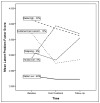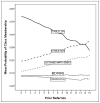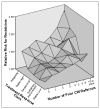Change trajectories during home-based services with chronic child welfare cases
- PMID: 21493617
- PMCID: PMC5609477
- DOI: 10.1177/1077559511402048
Change trajectories during home-based services with chronic child welfare cases
Abstract
This study examines how risk factor change patterns vary with case chronicity, and whether risk factor improvement still predicts lower recidivism risk among chronic cases. 2,175 parents in home based child welfare services were surveyed for risk factors at pre-treatment, post-treatment and 6-month follow-up. Mixture modeling of latent difference scores identified change trajectory classes related retrospectively to chronicity and prospectively to recidivism. Five change trajectories were identified: stable low problem, stable high problem, sustained improvement, relapsing, and paradoxical. Chronicity was associated with a decreasing probability of membership in the stable low problem trajectory and increasing probability of membership in the stable high problem and sustained improvement trajectories. Cases with more favorable trajectories recidivated less across levels of chronicity. Findings suggest that chronic cases may improve little, but still retain a stable or increasing chance of sustained improvement associated with lower risk. A cumulative service benefit might be one possible explanation for this observation, and might suggest that repeated intervention efforts are not always wasted on chronic cases. The current episodic and reactive service delivery model in child welfare may be a mismatch with chronic cases where progress is absent or tends to occur cumulatively across service episodes.
Conflict of interest statement
The author(s) declared no conflicts of interest with respect to the authorship and/or publication of this article.
Figures




Similar articles
-
Changes in parental depression symptoms during family preservation services.Child Abuse Negl. 2011 Jun;35(6):448-58. doi: 10.1016/j.chiabu.2011.02.005. Epub 2011 Jun 1. Child Abuse Negl. 2011. PMID: 21632109 Free PMC article.
-
Right care, first time: a highly personalised and measurement-based care model to manage youth mental health.Med J Aust. 2019 Nov;211 Suppl 9:S3-S46. doi: 10.5694/mja2.50383. Med J Aust. 2019. PMID: 31679171
-
Mothers in substance abuse treatment: differences in characteristics based on involvement with child welfare services.Child Abuse Negl. 2006 Jan;30(1):55-73. doi: 10.1016/j.chiabu.2005.07.005. Epub 2006 Jan 6. Child Abuse Negl. 2006. PMID: 16406024
-
Improving the mental health of children in child welfare through the implementation of evidence-based parenting interventions.Adm Policy Ment Health. 2010 Mar;37(1-2):27-39. doi: 10.1007/s10488-010-0274-3. Adm Policy Ment Health. 2010. PMID: 20143150 Review.
-
Engaging families in child welfare services: an evidence-based approach to best practice.Child Welfare. 2002 Mar-Apr;81(2):293-317. Child Welfare. 2002. PMID: 12014470 Review.
Cited by
-
Family outcomes in alternative response: A multilevel analysis of recurrence.Child Youth Serv Rev. 2022 Jan;132:106283. doi: 10.1016/j.childyouth.2021.106283. Epub 2021 Nov 9. Child Youth Serv Rev. 2022. PMID: 35250134 Free PMC article.
-
Trajectories of maltreatment re-reports from ages 4 to 12:: evidence for persistent risk after early exposure.Child Maltreat. 2012 Aug;17(3):207-17. doi: 10.1177/1077559512448472. Epub 2012 Jun 20. Child Maltreat. 2012. PMID: 22723495 Free PMC article.
-
Heterogeneity in Trajectories of Child Maltreatment Severity: A Two-Part Growth Mixture Model.Violence Vict. 2015;30(5):916-32. doi: 10.1891/0886-6708.VV-D-13-00114. Epub 2015 Aug 21. Violence Vict. 2015. PMID: 26300381 Free PMC article.
-
Toward tailored care for families with multiple problems: A quasi-experimental study on effective elements of care.Fam Process. 2022 Jun;61(2):571-590. doi: 10.1111/famp.12745. Epub 2021 Dec 21. Fam Process. 2022. PMID: 34931305 Free PMC article.
References
-
- Beck AT, Steer RA, Brown GK. BDI-II Manual. San Antonio, TX: The Psychological Corporation; 1996.
-
- Beck AT, Steer RA, Ball R, Ranieri WF. Comparison of beck depression inventories-IA and -II in psychiatric outpatients. Journal of Personality Assessment. 1996;67:588–597. - PubMed
-
- Chaffin M, Kelleher K, Hollenberg J. Onset of physical abuse and neglect: psychiatric, substance abuse, and social risk factors from prospective community data. Child Abuse & Neglect. 1996;2:191–203. - PubMed
-
- Chaffin M, Valle LA. Dynamic prediction characteristics of the child abuse potential inventory. Child Abuse & Neglect. 2003;27:463–481. - PubMed
-
- Cutrona CE, Russell D. The provision of social relationships and adaptation to stress. In: Jones WH, Perlman D, editors. Advances in personal relationships. Vol. 1. Greenwich, CT: JAI Press; 1987. pp. 37–67.

